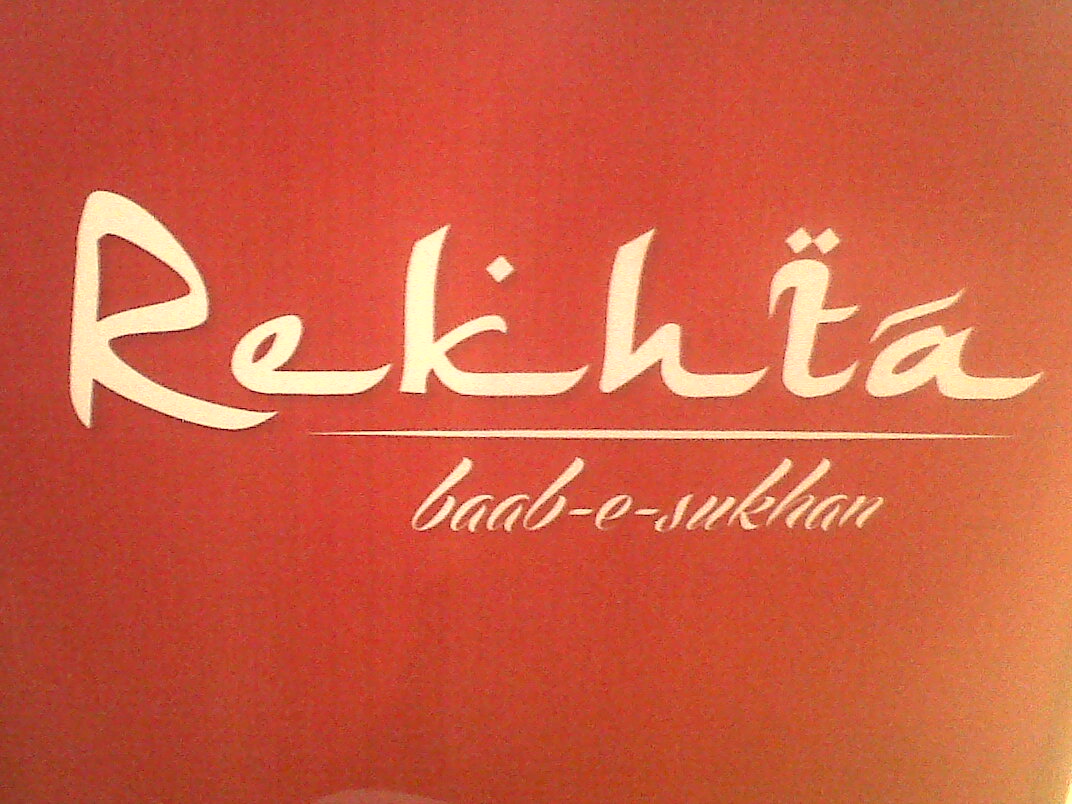Shers quoted in the name of Mirza Ghalib but actually they are not by Ghalib
For many, Urdu poetry is synonymous with Mirza Ghalib. Ghalib is the most quoted shayar and his shers are often quoted in various contexts. However, there are many shers which are famous in the name of Mirza Ghalib but scholars deny their authenticity as they are not part of Ghalib’s diwan. Here, we list out some of the most famous shers which are often mis-quoted in the name of Mirza Ghalib but actually they are not.
“Khuda ke waste parda na kabe se utha waaiz
Kahin aisa na ho yaan bhi wahi kaafir sanam nikle”
The above sher is sung by Jagjit Singh as a part of Ghalib’s ghazal but actually this sher is not anywhere found in Ghalib’s diwan.
Some other such shers are:
“Chand taswir-e-butaan chand haseenon ke KHutoot
Baad marne ke mere ghar se ye saamaaN nikla”
—–
“Zaahid sharaab peene de masjid men baiTh kar
Ya wo jagah bata de jahaaN par KHuda na ho’
—-
“Dil khush hua hai masjid-e-veeraaN ko dekh kar
Meri tarah khuda ka bhi khaana kharaab hai
This sher is though famous as Ghalib’s sher but is actually by Abdul Hameed Adam
—
Jis meN laakhoN baras ki hooreN hoN
Aisi jannat ka kya kare koi
—
This surely proves as Ghalib said
Hain aur bhi duniya meN sukhar-var bahut achchhe
kahte hain ki Ghalib ka hai andaaz-e-bayaaN aur”
The above Sher is by Ghalib 🙂
Filmy Shayari
Urdu shayari has been integral part of Hindi cinema especially till last few decades. Poets like Sahir ludhyanvi, Shakeel Badayuni, Hasrat Jaipuri, Akhtarul Iman, Majrooh Sultanpuri, Jaan Nisar Akhtar, Raja Mehdi Ali Khan have regularly written for films and have produced some of the immortal ghazals sung by various artistes like Lata Mangeshkar, Mohammad Rafi and others.
Though, the presence of ghazals in today’s cinema is diminishing – however, still some of the ghazals catches wide-spread appreciation when they become part of any film. To name them few like “Hoshwalon ko khabar kahaan” by Nida Fazli in Film Sarfarosh and “Haath chhute bhi to rishte nahi chhuta karte” by Gulzar in film Pinjar and “Koi fariyaad” by Faiz Anwar in film “Tum bin”.
Though there has always been a debate whether a song to be called ghazal or not. Rekhta has compiled the list of such pure ghazals and nazms which are part of films at a single place.
Watch these filmy ghazals at http://rekhta.org/FilmyPoetry
Urdu Poetry – Journey through TIME
Change and rebirth are inscribed in the D.N.A of Urdu poetry. It has been continuously reinventing itself in every phase of its existence through the last 300 years, both in its content and appearance. It is this adaptability that has enabled it to serve the emotional, intellectual and spiritual needs of poetry lovers at every point of time and space. The moving mirror of Urdu poetry has always reflected every change in the moods and patterns of thought and feeling of people at any particular period of time. It has also been a trend-setter in the way people live life and interprets it. Urdu poetry has given concrete shape to vague feelings and emotions and clearly audible expression to mute voices struggling to find words.
From the second half of the 17th to the first half of the 18th centuries, Urdu poetry passed through the phase of finding its linguistic move of expression it’s idiom from the linguistic resources of various languages like Braj, Punjabi, Gujri, Dakani etc. After establishing its linguistic base and contours, Urdu poetry took unbelievably fast strides on its way to excellence. 18th century saw the emergence of many great Urdu poets like Sauda, Dard, Mushafi with Mir Taqi Mir towering them all as one of the greatest bards not only of Urdu but all the languages in the world.
19th century was the era when the language gained in refinement and sophistication and rare ability to express complex and nuanced psychological, emotional and spiritual situations. Ghalib led the galaxy of Urdu poets like Momin, Aatish, Zauq in creating new benchmarks of excellence in poetry.
With end of the classical era in 1857, the entire Indian subcontinent came under the spell of far-reaching changes on many fronts. One front was the struggle against the colonial domination. On another front, the traditional ways of thought and action came under question. The progressive movement gave expression to both the anti-colonial and anti-tradition sentiment, resulting in producing a new wave of poetry dominated by an urge to seek equality and justice for all. Modernists soon followed to capture the nuances of human self and its spiritual angst.
Post partition, Pakistan started emerging as an independent centre of Urdu poetry, soon establishing its own idioms and content base in the works of Zafar Iqbal, Ahmad Mushtaq, Saqi Faruqi, and Munir Niyazi. In India, Urdu poetry found an entirely distinctive identity in Mohd. Alvi, Adil Mansoori, Shahryar, Baani, Nida Fazli etc from 1960s onwards.
In 1980, another waves emerged to invest the Urdu poetry with a voice that synthesised the progressive and modernist trends into a new poetic idiom, on both sides of the border. Presently, one sees in India an unprecedented surge in the interest in Urdu poetry, in terms of a growing number of youth writing poetry as well as those who read and listen to it. More interestingly, the high percentage of non-Muslims among the producers and consumers of Urdu poetry is reinvigorating the pluralist ethos of the Urdu language.
Saaqi- its various meanings in Urdu poetry
One reads and hears too much of tavern (maikhana), wine-flask (mina), wine-cup (saaghar) and wine-provider (Saaqi) in Urdu ghazals poetry. A newcomer to this poetry is often intrigued by frequent occurrence of these terms that tend to create an impression that the protagonist in the ghazal has nothing to do except boozing all the time. This impression is not incorrect to the extent one takes these terms in literal sense. But these terms assume new significance altogether the moment one comes to know their symbolic connotations.
The terms maikhana, Saaghar, mina, and saqi form part of the generic symbolic pattern of ghazal that the Urdu poetry has acquired from its Persian counterpart. Wine (mai, bada) with all its associations in Persian and Urdu ghazal poetry stands for the intoxicatedness that confronts and neutralizes the distractions generated by too much of rationality. Now the tavern (maikhana) becomes a place where one goes to get into a state of ecstasy and blissfulness.
Saaqi (wine-provider) is the presiding deity of this temple of intoxicatedness who provides wine as a source of ecstasy and rapture. Symbolically, Saaqi refers both to the beloved and God.
Saaqi has a mundane connotation when Dagh Dehlvi says:
Saaqi ab tishnagi ki taab nahi
Zahr de de agar sharaab nahin
(Unendurable is my thirst, O, Saaqi
Give me poison if there is no wine for me)
And it refers to the Divine in these lines by Iqbal.
Tere shiishe men mai baqi nahi hai
Bataa kya tuu mera saqi nahi hai
Samundar se mile pyas ko shab nam
Bakhili hai ye razzaaqi nahi hai
(There is no wine left in your flask
Tell me, aren’t you my Saaqi
Merely a dew- drop from an ocean
It’s niggardliness, not large-heated providence to me)
Some poets, like Ghalib, have also spinned the term Saaqi to invest it with still newer meanings. Ghalib says:
Hum tak kab uski bazm men aataa tha daur-e-jam
Saaqi ne kuch mila na diya ho sharaab men
(Never did the wine-cup reach me in her assembly
Saaqi might have added something to it as it now comes to me)
Sanjiv Saraf received award for promotion of Urdu language by Vice President Mr. Hamid Ansari
Sanjiv Saraf founder of http://rekhta.org/ received Nai Duniya, Faroge-e-Urdu Award for the promotion and development of Urdu Language by Hon’ble Vice President of India Hamid Ansari on 13th Sep. 2013.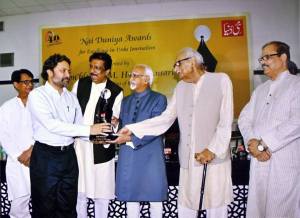
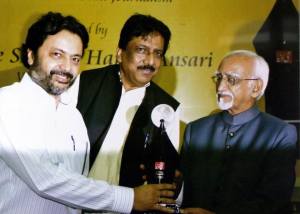
Aaj ka sher-4: piercing expression of dilemma by Saleem Ahmad
ye socha tha ke patthar ban ke jii luuN
so andar se pighalta ja raha huuN
This couplet by Saleem Ahmad (1927-1983) is one of the most striking and piercing poetic expressions in Urdu ghazals that emerged in 1960s with teh beginning of modernist trends in Urdu poetry across the subcontinent. The sher, in keeping with the best of ghazal tradition of combining the binary oppositions, juxtaposes two situations that a common man faces while dealing with the trials and tribulations of life.
The protagonist in the couplet, who is otherwise a very insensitive person, resolves to stonewall his heart and mind to spare him the pain and suffering. But this forced petrification of one’s own heart does not work as the fire of human concern and self-knowledge starts melting this stone of the heart.
One of the most touching shers ever written indeed.
Saleem Ahmad (http://rekhta.org/Poet/Saleem_Ahmed) was one of the most creative minds among the modernists, who expressed himself both in poetry and criticism. He lived in Karachi and is still remembered for some of his tradition-breaking ideas and shers.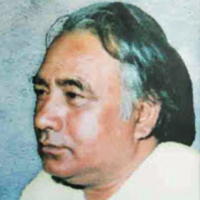
Aaj ka sher-3: Ghalib glorifying himself
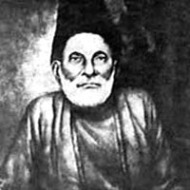
Farsi bin taabaabini naqsh haa-e-rang-rang
Ba-guzar az majmu-e-Urdu ke berang-e-man-ast
The above sher is by Ghalib in Farsi. Many people believe that Ghalib’s Persian shayari is superior than his Urdu shayari. And by the above sher, Ghalib himself says that his Persian poetry is very colourful while his Urdu poetry has no colurs in it.
However, Ghalib was great with play of words and he used his shayari beautifully to put forth his views. Contrarily, Ghalib again glorifies his Urdu poetry by the below sher and says that his Urdu poetry is superior than his Persian poetry.
jo ye kahe ke rekhta kyunke ho rashk-e-faarsi
gufta-e-Ghalib ek baar pa.Dh ke use suna ke yuu.n
We do not Ghalib’s Farsi or his Urdu shayari is superior. But, surely Ghalib was great!
Aaj ka sher: 2
The below sher is famously attributed to Bahadur Shah Zafar. However, very few people know that this was actually written by Muztar Khairadabi (1865-1927). And if you read the complete ghazal, this has got maqta (last sher of ghazal containing poet’s name- takhallus) of Muztar as well.
na kisi kii aa.nkh kaa nuur huu.n na kisii ke dil kaa qaraar huu.n
jo kisii ke kaam na aa sake mai.n vo ek musht-e-Gubaar huu.n
न किसी की आँख का नूर हूँ न किसी के दिल का क़रार हूँ
जो किसी के काम न आ सके मैं वो एक मुश्त-ए-ग़ुबार हूँ
http://rekhta.org/Gazal/na_kisii_kii_aankh_kaa_nuur_huun_na_kisii_ke_dil_kaa_qaraar_huun
Aaj ka sher
Taj Mahal, the symbol of love is being used in films and ghazals either as a reference to mehboob or as a symbol of love/beauty. Some of the finest shers about Taj-mahal are:
ek shahenshah ne daulat ka sahara lekar
ham ghariboN ki mohabbat ka uDaayaa hai mazaaq
-Saahir Ludhyanvi (part of a famous nazm named “Taj-Mahal” (http://rekhta.org/Nazm/8f06d9a2-6944-49d0-a048-448373aca0fe)
ek shahenshah ne banwa ke hasiN Tajmahal
saari duniyaa ko mohabbat ki nishanii di hai
– Majrooh Sultanpuri
एक कमी थी ताज महल में
मैं ने तिरी तस्वीर लगा दी
-Kaif Bhoplai
Rekhta promoting young poets
In its endeavour to promote young Urdu poets and provide them a global platform and recognition, Rekhta has initiated an intiative to record their best ghazals/shers and post them on youtube and other social media. Rekhta identifies young talents and record/publish them on Rekhta.
Along with young poets, Rekhta also records renowned poets and personalities and publish them for their archival values.
You may enjoy their videos at http://rekhta.org/VideoStudio
Please contact us if you want to contribute or you want to feature your ghazals on Rekhta.
